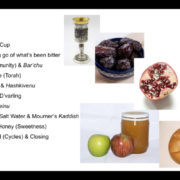Runway to the Days of Awe 5: What to Expect
Dear CBI Members and Friends,
The Days of Awe are drawing nearer! I’m writing this week with more information about what you can expect from our Zoom services in general, and specifically, what you can expect from our erev Rosh Hashanah ma’ariv (evening service) and seder.
Days of Awe on Zoom

Our services on Zoom will not be exactly like the services we’ve held in person in years past. Trying to replicate the experience of being together in shul might just remind us of what we’re missing (in-person togetherness). Instead, we’re embracing what’s different about this year, and what’s possible in this new medium that we can’t do in person.
Never fear: we will still have many of the features of “regular” high holiday services: familiar words, familiar melodies, familiar prayers. Avinu Malkeinu (as a niggun on Saturday; with words once it’s no longer Shabbes), shofar-blowing (before Shabbat and Rosh Hashanah formally begin, and on second day Rosh Hashanah and at Ne’ilah), and more.
There will also be images on every slide. And occasional videos. (We can’t sing together in harmony over Zoom, but we can sing along with some of the Jewish world’s finest!) Our encounters with Torah and haftarah will be different than ever before, sometimes involving video, sometimes involving new voices. Every so often I’ll stop the slideshare for a moment of “face to face” time, where instead of seeing the words and images in the slides, we’ll see each others’ faces and connect as a community.
On the second morning of Rosh Hashanah, our service will interweave liturgy with a selection of contemporary poems. We’ll also have the opportunity to hear shofar on the second morning (not on the first morning, because traditionally shofar is not blown on Shabbat.) Our service on second morning will not include a sermon, but will include a Torah video and discussion.
Speaking of sermons, all of my sermons will also be shared on YouTube for those who want to watch the sermons but aren’t inclined to daven (pray) with us on Zoom or Facebook Live.
(Our hope is that most of you will join our services via Zoom, so that we can see each others’ faces. We will also “broadcast” our services from Zoom to the synagogue’s Facebook page. Those who participate via Facebook instead of Zoom will miss the intimacy of the times when we stop the screenshare for “face to face” time, and won’t be able to see the faces of others in our community — but will be able to view the services asynchronously, e.g. after they are over.)
I’m spending the summer crafting this new High Holiday experience for all of us, and connecting with colleagues across the denominations to share ideas and best practices. I’m deeply hopeful that our High Holiday Zoom experiences will speak to your hearts.
About Our Rosh Hashanah Seder

The Sefardic / Mizrahi custom of the Rosh Hashanah seder is ancient — dating back at least as far as the Talmud, circa 500 C.E. — and in many homes quite elaborate. In a traditional Rosh Hashanah seder, there are many symbolic foods whose names are Hebrew puns — e.g. eating carrots (gezer) as a wish for positive judgement, because their name sounds like gezerah (decree, as in God’s decree of our fate.)
Our Rosh Hashanah seder will feature four cups (just like the Passover seder). The first three cups (or sips) will be grape juice or wine. Our fourth cup will be a cup from which we do not drink — a cup of salt water, representing our tears of mourning as we prepare for mourner’s kaddish.
Our Rosh Hashanah seder will also feature symbolic foods, some of which we will distribute in our High Holiday boxes (sign up by September 7 if you want one!)
We’ll taste a bite of maror as we let go of the old year’s bitterness. (Do you have a jar of horseradish? If not, how about a bite of raw onion, or even a sip of vinegar.) We’ll eat pomegranate seeds during the prayer that speaks of Torah and mitzvot, as an embodied wish for mitzvot in the new year. We’ll eat dates before the Bar’chu as a symbol of meaningful relationship. And at the end of the seder we’ll bless apples and honey (sweet foods for a sweet year) and bless a round food (a roll, a challah, even a rice cracker — whatever you’ve got) to represent the cycle of time and how each year we come back around to the beginning again.
(We plan to include pomegranates, dates, apples and honey in the Holiday Box. It’s up to you to come up with grape juice or wine, salt water, a round challah or roll or cracker, and something bitter / spicy for maror.)
In between these seder steps, we’ll pray the evening service, sanctifying the transition from day to evening, from weekday to Shabbat, from ordinary time to festival time, and from the old year to the new.
I can’t wait to celebrate with you soon.
Blessings to all,
Rabbi Rachel
The Runway to the Days of Awe
- Week One: Seven Weeks Until Rosh Hashanah
- Week Two: Creating Sacred Space at Home
- Week Three: Music
- Week Four: Clothing
- Week Five: What to Expect





